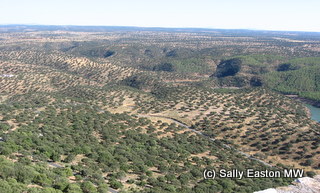Cork oak forests
Cork oak landscapes cover over 2.5 million hectares in Portugal, Spain, Algeria, Morocco, Italy, Tunisia and France. They are part of the World Wide Fund for Nature’s (WWF) ‘critical/endangered’ Mediterranean forests and scrubland ecosystems, typified by cool, moist winters and hot, dry summers.

Cork oak landscape
Cork forests have a wealthy biodiversity, reaching up to 135 plant species per square metre. This alone makes them an important resource for the planet. But cork oak forests are also managed landscapes, so key concerns for the WWF are to achieve an environmental, social and economic balance in them. They argue “over the last decade, damaging policies, poor forest management and a change of the cork market have resulted in the degradation and loss of these unique habitats,” suggesting the biggest threats are man-made: overgrazing, over-harvesting, over-conversion to agriculture, over-clearing forest, and simply abandoning the land.
That cork trees are harvested only every 9 to 12 years, and only after the tree is already at least 25 years old, means cork tree husbandry is a multi-generational issue. For cork stoppers, the first harvest cannot be used as the quality is insufficient, so a tree will be around 35 years old before it first becomes potentially useful for cork stoppers. It is worth the wait, because cork stopper production accounts for two-thirds of the total value of the cork market, other uses including flooring, insulation etc. It is probably for this reason that the WWF has targeted the wine industry.
In the meantime, income must be derived for cork forest owners. It is their portfolio of activities, usually comprising stopper production, hunting, agricultural crops such as pine nuts, cheese and honey, and livestock grazing, that has the potential to damage cork oak landscapes.
Cork oak tree regeneration is the big issue, whether natural or by artificially planting seedlings. Hunting is profitable, and the temptation is significant to graze more livestock than the delicately balanced forest landscape ecosystems can tolerate. Cork oak seedlings are fragile things which need many years to establish themselves. Too-frequent hunts and too many livestock prevent them from establishing, and as few as one cow or three sheep per hectare can be too many. WWF say the number of livestock is not regulated, but that it may need to be in the future. Conservation of landscape biodiversity in conjunction with an economic return is no easy ask, but at least the WWF are evaluating cork forest landscapes as entire natural and cultural ecosystems which should enable a clearer picture of all the elements of management and landscape to emerge.



